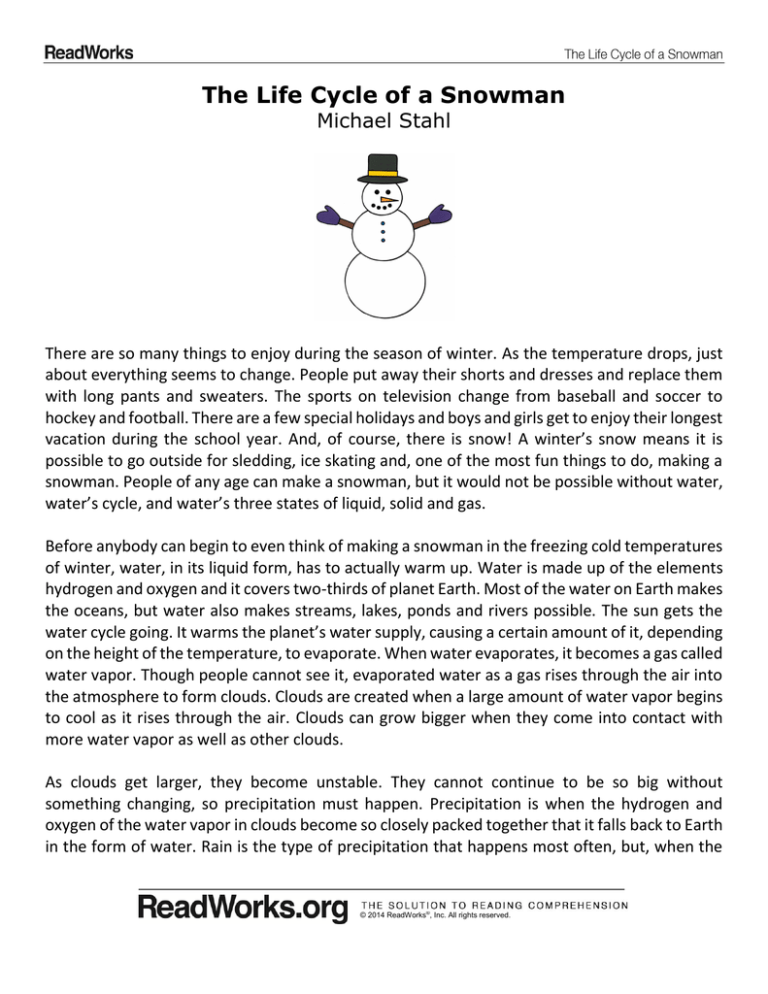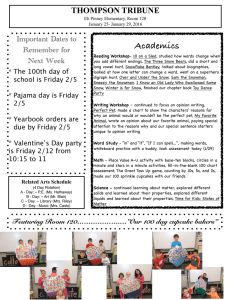The Life Cycle of a Snowman Michael Stahl
advertisement

The Life Cycle of a Snowman Michael Stahl There are so many things to enjoy during the season of winter. As the temperature drops, just about everything seems to change. People put away their shorts and dresses and replace them with long pants and sweaters. The sports on television change from baseball and soccer to hockey and football. There are a few special holidays and boys and girls get to enjoy their longest vacation during the school year. And, of course, there is snow! A winter’s snow means it is possible to go outside for sledding, ice skating and, one of the most fun things to do, making a snowman. People of any age can make a snowman, but it would not be possible without water, water’s cycle, and water’s three states of liquid, solid and gas. Before anybody can begin to even think of making a snowman in the freezing cold temperatures of winter, water, in its liquid form, has to actually warm up. Water is made up of the elements hydrogen and oxygen and it covers two-thirds of planet Earth. Most of the water on Earth makes the oceans, but water also makes streams, lakes, ponds and rivers possible. The sun gets the water cycle going. It warms the planet’s water supply, causing a certain amount of it, depending on the height of the temperature, to evaporate. When water evaporates, it becomes a gas called water vapor. Though people cannot see it, evaporated water as a gas rises through the air into the atmosphere to form clouds. Clouds are created when a large amount of water vapor begins to cool as it rises through the air. Clouds can grow bigger when they come into contact with more water vapor as well as other clouds. As clouds get larger, they become unstable. They cannot continue to be so big without something changing, so precipitation must happen. Precipitation is when the hydrogen and oxygen of the water vapor in clouds become so closely packed together that it falls back to Earth in the form of water. Rain is the type of precipitation that happens most often, but, when the © 2014 ReadWorks®, Inc. All rights reserved. temperature in the air is particularly cold, the water falling down to Earth chills and becomes snow. Snow and ice are examples of water being in its solid state. Precipitation can also include hail and sleet. Hail is precipitation as pieces of ice formed in cloud layers that are below freezing levels. Sleet is when the water is somewhere in between rain and snow. If the temperature is cold enough and if clouds overhead are big and unstable enough, snow will fall to the ground. If the snow starts to accumulate on the ground, then one can possibly make a snowman. A person or group of people needs a lot of snow to make a snowman. They will need to pack up enough of that snow to make three tremendous balls, one for the base or the legs, another for the middle part of the body, and one, usually smaller than the others, for the head. It’s best to decorate a snowman with a hat, a scarf, and some eyes and a mouth made of coal, or other objects. Snowmen are fun while they last, but the Earth’s water cycle has to continue on. Eventually, no matter how much a person might wish for it not to be the case, the snowman will warm up from the sun and melt, turning back into water and being sopped up by the ground. However, over time, that water will only evaporate back into the air to form more clouds that will make more snow for more snowmen. © 2014 ReadWorks®, Inc. All rights reserved. Questions: The Life Cycle of a Snowman Name: Date: 1. How many states of water are there? A B C D one two three four 2. The sequence of the water cycle is described in the passage. What happens after the sun warms the planet’s water supply? A B C D Water evaporates and becomes a gas called water vapor. Water vapor rises through the air into the atmosphere and cools. Clouds come into contact with more water vapor and grow larger. Large clouds become unstable and cause precipitation. 3. Cool air is needed to form clouds. What evidence from the passage supports this conclusion? A B C D Clouds grow larger as they come into contact with other clouds. Water vapor cools as it rises through the air, which creates clouds. As clouds get bigger, they become unstable. This causes precipitation. When water evaporates, it becomes a gas called water vapor. 4. Read the following sentences: “Rain is the type of precipitation that happens most often, but, when the temperature in the air is particularly cold, the water falling down to Earth chills and becomes snow.” Which of the following conclusions is supported by the passage? A B C D The air is usually too cold for snow to form. It hails more often than it snows or sleets. The air is usually too warm for snow to form. It rains most often because liquid is water’s natural state. 5. What is this passage mostly about? A B C D precipitation snowmen water vapor the water cycle 1 © 2014 ReadWorks®, Inc. All rights reserved. Questions: The Life Cycle of a Snowman 6. Read the following sentences: “Snowmen are fun while they last, but the Earth’s water cycle has to continue on. Eventually, no matter how much a person might wish for it not to be the case, the snowman will warm up from the sun and melt, turning back into water and being sopped up by the ground.” As used in this sentence, what does “eventually” most nearly mean? A B C D in the end in the beginning in the middle for a long time 7. Choose the answer that best completes the sentence below. When water evaporates it becomes a gas called water vapor. ______ it rises through the air and cools to form clouds. A B C D Like So But Then 8. Name four different kinds of precipitation. ______________________________________________________________________ ______________________________________________________________________ ______________________________________________________________________ ______________________________________________________________________ 2 © 2014 ReadWorks®, Inc. All rights reserved. Questions: The Life Cycle of a Snowman 9. Describe how precipitation is caused. ______________________________________________________________________ ______________________________________________________________________ ______________________________________________________________________ ______________________________________________________________________ 10. Explain how the water cycle continually repeats itself. Use information from the passage to support your answer. ______________________________________________________________________ ______________________________________________________________________ ______________________________________________________________________ ______________________________________________________________________ 3 © 2014 ReadWorks®, Inc. All rights reserved.






